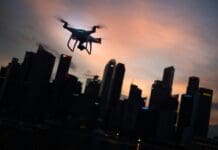This post is also available in:
 עברית (Hebrew)
עברית (Hebrew)
The INNOTECH International Live Conference Broadcast for HLS, Cyber and Innovation on December 8-9 will host the leading experts at the intriguing panel discussion. You will be able to watch the special broadcast and interact with the participants.
Avi Yariv, a cyber, intelligence, and HLS expert, iHLS co-founder is the Chairperson of INNOTECH. The conference and discussion panels will be narrated by Ya’akov Eilon, a journalist and TV news presenter.
Yigal Unna, the Director-General of the Israel National Cyber Directorate (INCD) will open the cyber session. Unna has three decades of experience in the Israeli security apparatus. Among other roles, he served as Head of the SIGINT-Cyber Division in the Israeli Security Agency.
The panel on Space will be opened by Avi Blasberger, the Director-General of the Israel Space Agency. Blasberger has fulfilled various roles in Elbit Systems companies for 30 years, including CEO of Elbit Security Systems.
One of the major discussion topics in the broadcasted conference will be Innovation in the IDF. How does the military deal with innovation, and how does it manage the transformation from the civilian to the military sector? How does it harvest the fruits of innovation for its own purposes?
The Cyber Discussion Panels, chaired by Guy Mizrahi, Chief Cyber Officer, Rayzone Group, will focus on current dilemmas, especially over the backdrop of the COVID-19 challenges:
The use of spying products on citizens during a pandemic – Israel has always activated intelligence measures vis a vis foreign or local citizens on the basis of a specific court order, in cases of terrorist or criminal acts. The COVID-19 pandemic has raised the need to activate this measure vis a vis the population as a whole. What are the dangers involved and how can we minimize and manage them? How far can you go sacrificing your privacy for security?
Unclear boundaries – who moved my information? – Most of our private information which had been previously stored in computers is now dispersed in cloud storages that we are not aware of. Among other things, we give up privacy for the sake of comfort, usability, and friendliness.
The question is who manages this information and who is interested in taking and using it? Commercial companies exploit information in order to produce money. What kind of regulation is supposed to secure this information, what are the current defense concepts, and which technologies could provide the response to safeguarding this information?
The future and cyber innovation – As opposed to the constant character of humans, technology changes at an extremely fast rate. What will the development rate be and which factors will influence it?
Futurology identifies technological and social trends and extrapolates from the past regarding what is expected in the future. In human evolution, there sometimes appears a singular point that revolutionizes current order and changes completely the direction. Will cyber continue to develop in an evolutionary pattern or will a singular point change everything. For example, quantum computing could be such a turning point.
Asymmetry in cyber attacks – Next-generation IR – The provision of a cybersecurity strategy for an organization involves the deployment of a threat analysis which leads to customized protection. The extent of investment required is dictated by the threat analysis. The problem is that organizations do not expect attacks by power states but rather by hackers.
The intersection between the organization’s self-defense needs and the assailant state entails an asymmetry that creates a substantial gap between defense and offense capabilities.
How can organizations cope with the balance of terror emanating from an attack by a great power?
OT, IoT, and SCADA – In the industry and critical infrastructure realm, operational technology (OT, SCADA) of critical infrastructures is based on legacy control equipment connected to the IT world and the network. How can we protect these infrastructures and defend the connection between IT and OT? How can technological innovation help?
HLS Discussion Panels, with chairperson Brig. Gen. (res.) Sharon Nir, former commander of IDF National School of Communication & Cyber Defense, former Gender Advisor to the Chief of Staff, will discuss the added value of personal security for the public’s quality of life:
Smart and safe cities vs. “comfortable cities” and quality of life – The strive for increased personal security and public safety in the city has created the safe city concept: cities networked with communication systems, sensors, cameras, and digital access to emergency centers, C2 systems, and more. Smart technologies have been embedded in the safe city infrastructure, IoT-based internet solutions, providing also quality of life and prosperity to the city and its citizens. The smart city solutions refer to all aspects of life, including transportation systems, power stations, water pipe infrastructure, garbage collection, law enforcement, circling the citizen by a technological envelope in various fields of life. The centrality of the local authority during the COVID-19 era and the need for social distancing have empowered the requirement to accelerate smart city technology.
But what are the limitations on the quality of life and the right to privacy, imposed by security? What is the relation between technology-based operational efficiency vs. quality of life?
Cellular 5G as an enabler or thwarter: added value, regulation, threats, and opportunities – Fifth-generation technology – 5G – consists of a quantum leap and a technological accelerator for information transfer at the highest rate! What are the capabilities provided by this innovative technology and how does it influence people’s lives from the aspects of security, privacy, information transfer rate, etc.?
Personal security during the COVID-19 age – The fight against the COVID-19 pandemic has accelerated the need to develop and embed information systems in order to break the chain of transmission. This requirement has attributed a special emphasis on the interests related to individual aspects and medical confidentiality vs. vital interests regarding public health aspects. These challenges have intensified the need to develop AI-based information systems as an effective tool to break the chain of transmission while preserving individual rights, mainly to medical confidentiality.
Medical records confidentiality is one of the major challenges, as well as the way this information is used. Coping with a pandemic requires the analysis of information in medical records in order to produce insights regarding trends, patterns, etc. that influence the epidemic. What is the point where the right to privacy ends and the public good becomes first priority?
Innovation Discussion Panels, with Chairperson Ran Natanzon, Head of Innovation and Country Branding, Israel Ministry of Foreign Affairs, will elaborate on how innovation is enabled in various contexts, and look into the accelerating factors vis a vis the barriers:
Future infrastructure – the next generation of managing and securing cities and infrastructures – The infrastructure realm has been undergoing a transformation right before our eyes, turning into an arena where technology influences the activity in the field, the sensors that are now available more than ever provide real-time critical information, and big data systems are improving processes and responses in real-time. All these, integrated with additional technologies, are improving the processes and increasing their efficiency both on the cities and infrastructure companies’ side and on the customer’s side. Everything is becoming smart and efficient, cities, transportation, and water and electricity grids. What are the opportunities that can evolve from this process?
Space – the New Domain – The near-space has become more accessible, and after the drone revolution, the growing availability of satellites and mini-satellites opens a new world of opportunities. What opportunities does this domain have to offer?
This new space level offers almost infinite potential for communications, pharma, experiments, data analysis, etc. Thanks to their compact structure and low cost, mini-satellites will gradually replace the large and expensive ones in research missions, for example as mini-labs conducting experiments in biology, chemistry and medicine in microgravity conditions. Others, such as the Space-X’s Star Link project, provide internet access to large areas on earth.
Innovation in the IDF – Military organizations around the world have been adopting more and more technological innovation from the civilian, commercial realm. How does the military deal with innovation, and how does it manage the transformation from the civilian to the military sector? How does it harvest the fruits of innovation for its own purposes?
It is also of interest to find out how does the military persuade innovative minds to stay within its ranks, and how does it manage and encourage innovation, turning ideas into reality, vis a vis the competition at the civilian market.
Today, there is an internal innovation in the IDF and an external one. The IDF understands that the civilian realm has been accelerating technology, and today, the Army is recruiting innovation programs, and more and more startups have been integrated into the IDF.
Currently, the IDF is capable of integrating innovation and there are dedicated programs for this, e.g. INNOFENSE. During the COVID-19 crisis, the IDF has performed a leading role and succeeded in rapidly integrating innovation and startups in order to support and shorten processes during an emergency.
Innovation of Innovation – how to bring innovation into organizations? – Innovation has become a central pillar of every modern organization: in the industry, high-tech, and government. The challenge of the rapid renewal of work and services principles preoccupies all the leading organizations around the world. How can you offer an alternative to the startup ecosystem? Is it preferable to purchase technology? What is best – to establish an internal or external accelerator? How do you overcome the barriers on the way to innovation – organizational culture, leadership, the lack of structured innovation approach, not allowing sufficient time for innovation due to the focus on the delivery of core products, and more. How can large organizations overcome these obstacles? What role should the organization’s leadership play, and what tools can it use?
*The agenda is subject to changes by the organizers
INNOTECH International Live Conference Broadcast for HLS, Cyber and Innovation


























